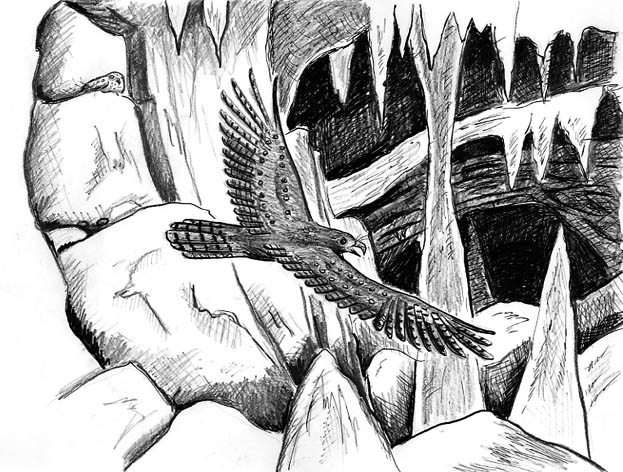
Dear Bird Folks,
I was reading a story about bats and their ability to find food by using echolocation. The article stated that some birds also use echolocation, but it never mentioned which birds they were. This is where you come in. Do you know what birds use echolocation to find food?
– Russell, Cambridge, MA
None, Russell,
No birds use echolocation to find food. There, that was easy. What other questions do you want me to answer? We have a little extra time now so if anything else comes to mind I’d be happy to answer it for you. Just don’t ask me that one about a train leaving Chicago at 2:00, traveling at 100MPH, while another train leaves New York at 3:00, at the speed of…blah, blah, blah. I always hated that question. Does anyone really need to know that? Is it a critical bit of knowledge that we can’t live without? I mean it’s not like knowing about a bird’s ability to use echolocation. That’s one of life’s truly essential pieces of information. And yes, there are birds that do use echolocation; only none of them use echolocation to “find food.” They use it to find their way home. Aw! How cute.
Of the roughly 10,000 different species of birds in the world only a handful have the adaptations needed to effectively fly around in total darkness; surprisingly, none of these birds are owls. These few birds all have one thing in common: they live in deep, dark caves and must use echolocation to find their way back to their nests, not to obtain food. In the Americas we have only one bird with that ability. That bird is the super-strange Oilbird of South America. Yup, there really is something called an “Oilbird” and there is no other bird like it in the entire world.
Oilbirds look a bit like, and are related to, our pals of summer nights, the Whip-poor-wills. Both birds are nocturnal, but the Whip-poor-wills are totally insectivores, while the picky Oilbirds only eat fruit. Good for them. I’d take fresh fruit over icky bugs any day. However, the birds pay a price for their fruit fetish. Their babies grow very slowly. It takes several months for young Oilbirds to grow on their produce-only diet. By comparison, the insect-fed Whip-poor-wills’ babies are up and flying a measly sixteen days after they hatch. If Oilbirds nested on the ground, as the Whip-poor-wills do, their slow growing babies would most likely become a meal for some passing predator. To keep their kids out of the food chain, the Oilbirds, according to one theory, have opted to build their nests deep inside caves. In the caves the only things they have to deal with are stalactites, trolls or one of those weird spelunking dudes. And oh yeah, they have to deal with the total darkness, too.
After a night of fruit foraging the Oilbirds return to their cave and immediately begin to emit clicking sounds. Like a bat or a submarine’s sonar the birds use the clicks to help them fly through the cave and avoid the stalactites and spelunkers. The impressive thing is that Oilbirds don’t have tiny, easy-to-maneuver bat bodies; they are big, crow-sized birds with three-foot wingspans. And not only is an Oilbird able to make its way through the cave’s many twists and turns in total darkness, but it can somehow find its way to its own nest, among all of the other Oilbird nests. That’s impressive considering some of us can’t figure out how to drive around a rotary in broad daylight.
The Oilbird’s clicks may help them find their way home, but they don’t help them find a meal. Owls find prey at night by using their superb vision and hearing, which allows them to hear faint squeaks or to spot movement. Unfortunately, Oilbirds can’t do that because fruit rarely moves and is traditionally very quiet. Instead, the birds use a sense not employed by many birds – their sense of smell. Some of the fruit the Oilbirds eat is extremely fragrant and it is thought they are able locate their food by following the aroma.
How did the Oilbird get its rather odd name? First, I must warn you that the answer is a little gruesome. If you are squeamish you may want to stop reading this right now and go do something a little less grisly, like watch one of those happy-go-lucky TV crime dramas where they only kill about ten guys each week. They are called Oilbirds because the young birds are filled with oil. Well, sort of. After months of a nonstop diet of tropical fruit, especially oil palm fruit, combined with zero exercise (kids never learn), the baby birds are way overweight. In fact, they weigh 50% more than their parents do and most of that weight is fat. Indigenous people would often steal the tubby babies, boil them down and use the oil for cooking and fueling lamps. Lovely, eh?
That’s the story behind Oilbirds and their echolocation skills. If you ever want to try echolocating on your own, Russell, do this. The next time you have to get up during the night, don’t turn on a light. Instead, start making clicking sounds and see how far you get before you stub your toe, or before your wife calls the cops.